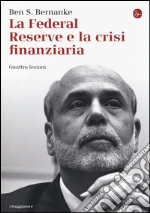 Libri di Bernanke Ben S. su Unilibro.it) Libri di Bernanke Ben S. su Unilibro.it)
|
|
2024 |
 Title :
Principles of economics
Title :
Principles of economicsAuthor: Frank Robert; Bernanke Ben S.; Antonovics Kate Publisher: McGraw-Hill Education € 74,99
|
|
|
2022 |
 Title :
Principles of economics
Title :
Principles of economicsAuthor: Frank Robert H.; Bernanke Ben S.; Antonovics Kate Publisher: McGraw-Hill Education € 74,99
|
 Title :
Principi di economia. Con connect
Title :
Principi di economia. Con connectAuthor: Frank Robert H.; Bernanke Ben S.; Antonovics Kate; Ottone S. (cur.); Ponzano F. (cur.) Publisher: McGraw-Hill Education Il testo è stato migliorato sia nella parte di microeconomia sia in quella di macroeconomia, al fine di renderlo sempre più fruibile didatticamente. In molti punti il manuale è stato snellito e in altri integrato rifacendosi alla nuova edizione inglese, al fine di creare uno strumento ancora più adeguato e completo per un corso di base. In particolare, sono da segnalare la scelta di mettere tutte le appendici sul web e l'introduzione di due capitoli scritti ex novo: il capitolo 15 (economia comportamentale) e il capitolo 32 (riguardante le crisi). € 58,00
Scontato: € 55,10
|
|
2016 |
 Title :
Macroeconomia
Title :
MacroeconomiaAuthor: Bernanke Ben S. Publisher: ISEDI € 51,00
Scontato: € 48,45
|
|
|
2014 |
 Title :
La Federal Reserve e la crisi finanziaria. Quattro lezioni
Title :
La Federal Reserve e la crisi finanziaria. Quattro lezioniAuthor: Bernanke Ben S. Publisher: Il Saggiatore Come funziona una banca centrale? A quali princìpi orienta la sua politica monetaria? Come sceglie se privilegiare il contenimento dell'inflazione o la piena occupazione? Che cosa può fare durante una crisi finanziaria, e come può stimolare l'economia in tempi di recessione? Dal 200Ó al 2014 Ben Bernanke è stato presidente della Federal Reserve, la banca centrale statunitense. Le lezioni qui raccolte abbracciano teoria e storia, e ricostruiscono le vicende della Fed, fondata nel 1914: dagli errori durante la Grande depressione alla Grande moderazione sotto la ventennale presidenza Greenspan, passando per il 'divorzio' dal dipartimento del Tesoro nel secondo dopoguerra e per l'inflazione degli anni settanta, sedata dall'allora governatore Volcker. Bernanke approfondisce poi le origini e i meccanismi della crisi finanziaria scoppiata nel 2008, rivela i retroscena degli interventi che hanno salvato il sistema bancario dal collasso ed esamina gli sforzi messi in atto per rilanciare la crescita degli Stati Uniti. Al centro dell'analisi, la funzione di prestatore di ultima istanza che nel 2008 la Fed ha esercitato per arginare il panico e salvare gli istituti too big to fail, ma anche le meno convenzionali politiche espansive, come l'acquisto di titoli su larga scala. Una ripresa impossibile, ribadisce Bernanke, senza una regolamentazione finanziaria efficace e politiche fiscali coerenti, obiettivi che le banche centrali non possono certo perseguire da sole. € 16,00
Scontato: € 15,20
|
|
|
2001 |
 Title :
Inflation Targeting
Title :
Inflation TargetingAuthor: Bernanke Ben, Laubach Thomas, Mishkin Frederic S., Posen Adam S. Publisher: Princeton Univ Pr How should governments and central banks use monetary policy to create a healthy economy? Traditionally, policymakers have used such strategies as controlling the growth of the money supply or pegging the exchange rate to a stable currency. In recent years a promising new approach has emerged: publicly announcing and pursuing specific targets for the rate of inflation. This book is the first in-depth study of inflation targeting. Combining penetrating theoretical analysis with detailed empirical studies of countries where inflation targeting has been adopted, the authors show that the strategy has clear advantages over traditional policies. They argue that the U.S. Federal Reserve and the European Central Bank should adopt this strategy, and they make specific proposals for doing so. The book begins by explaining the unique features and advantages of inflation targeting. The authors argue that the simplicity and openness of inflation targeting make it far easier for the public to understand the intent and effects of monetary policy. This strategy also increases policymakers' accountability for inflation performance and can accommodate flexible, even 'discretionary,' monetary policy actions without sacrificing central banks' credibility. The authors examine how well variants of this approach have worked in nine countries: Germany and Switzerland (which employ a money-focused form of inflation targeting), New Zealand, Canada, the United Kingdom, Sweden, Israel, Spain, and Australia. They show that these countries have typically seen lower inflation, lower inflation expectations, and lower nominal interest rates, and have found that one-time shocks to the price level have less of a 'pass-through' effect on inflation. These effects, in turn, are improving the climate for economic growth. The authors warn, however, that the success of inflation targeting depends on operational details, such as how the targets are defined and when they are announced. They also show that inflation targeting is not a panacea that can make inflation perfectly predictable or reduce it without economic costs. Clear, balanced, and authoritative, Inflation Targeting is a groundbreaking study that will have a major impact on the debate over the right monetary strategy for the coming decades. As a unique comparative study of what central banks actually do in different countries around the world, this book will also be invaluable to anyone interested in how economic policy is made. € 40,80
|
|
|
1994 |
 Title :
Macroeconomia
Title :
MacroeconomiaAuthor: Abel Andrew B.; Bernanke Ben S.; Golinelli R. (cur.) Publisher: Il Mulino Gli autori presentano e discutono gli aspetti teorici della disciplina sempre a partire da esempi concreti e da problemi economici di lungo periodo. Inoltre gli esempi su cui si esercita l'analisi sono prevalentemente riferiti alla situazione italiana (le cause degli alti tassi di risparmio, gli effetti del deficit pubblico e dello squilibrio della bilancia dei pagamenti e così via). € 32,02
|